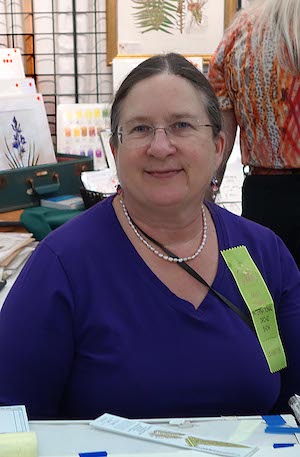Linda Ann Vorobik
Last Updated on March 23, 2024 by Tom Pratum

When Linda was just a baby, her parents bought 34 acres on Lopez Island, the perfect setting to learn about the natural world around her. She started by helping her mother in the garden, then expanded to surrounding natural areas. Her parents taught her the names of the native plants and gave her art supplies for birthday and holiday gifts, encouraging her natural artistic talents as well. She took every class that her favorite high school teacher, Coleman Leuthy, taught: botany, chemistry, photography, and more. Based on her love of animals, she started college with the intention of becoming a veterinarian. She soon realized that ecology, botany and geology were more exciting and involved studying outdoors, and the labs smelled wonderful, not like the preservatives used for animal specimens. At Western Washington University in Bellingham, she acquired two mentors: Dr. Ron Taylor (author of Sagebrush Country) and Dr. Rich Fonda (vegetation of the San Juan Islands and the Olympic Peninsular river terraces). She completed a BA in biology with a minor in math in 1977.
In 1978 she worked for The Nature Conservancy Natural Heritage Program and spent a year with Jean Siddall assembling the first rare plant list for Oregon. One weekend during that year she visited the Siskiyou Mountains and fell permanently under their spell. The summer of 1979 she went to Ketchikan, Alaska, to work as the sole field botanist for the Tongass National Forest. This was during the first year of her Fellowship with Dr. David Wagner, where she worked in the herbarium and assisted with the spring Systematic Botany class. Wagner encouraged both her artistic and botanical interests with his “zen-like approach to academics.” Linda went on to earn a PhD in Biology in 1985 with fieldwork in the Siskiyou Mountains. Her dissertation was Hybridization and Reproductive Isolation between Sympatric Arabis (Cruciferae) in Southwestern Oregon.
Linda took five art classes while in college. She tells us that, while she learned from wonderful art teachers in junior high and in high school, her experience in college was a different story. When she presented her first plant drawing to her college art teacher, he told her, “That’s not art.” But when she saw the botanical illustrations by Jeanne Janish in Vascular Plants of the Pacific Northwest, Linda realized, “I want to learn how to do this.” She showed Janish’s illustrations to Dr. Taylor in her systematic botany class and shared her interest in learning how to create illustrations like Janish. A couple weeks later, Dr. Taylor proposed that she create illustrations for his lab manual.
Many drawings and a few months later, Linda had earned 9 credit hours creating botanical illustrations, and Washington Native Plant Society members are still using these illustrations in a botany primer. After graduation Dr. Taylor paid her $100 to draw four new plates for the glossary of his lab manual. Later, Linda had the opportunity to learn from Janish in person at a one-day workshop at Southern Oregon University (sponsored by Dr. Frank Lang). Janish was kind enough to correspond with her afterwards and provided continual feedback about her work. Almost all of Linda’s professional botanical illustration is based on herbarium specimens, but you wouldn’t know it by looking at them. She has developed the ability to transform dry flattened plants into illustrations that appear three-dimensional.
Thus, Linda juggles two specializations: plant systematics and botanical illustration. She is a Visiting Scholar at the University Herbarium at UC Berkeley and at the University of Washington in Seattle. (We are fortunate that her commute takes her through Oregon; her enthusiasm and generosity have enriched our knowledge of its flora.) She served as principal illustrator for The Jepson Manual, Flora of North America Vol. 25, and numerous other floras, and has illustrated many new species for a variety of authors. Since 1993 she has earned her living as a freelance botanist/botanical illustrator, and continues to conduct field research as well, no small feat in this world. She teaches botany and botanical illustration workshops in California, Oregon, and Washington, as well as an orchid-painting workshop in Hawai’i. In addition to scientific illustration, she creates fine art in the form of botanical watercolors, prints, cards, and silk scarves.
Linda has been an active member of the Native Plant Society of Oregon since her botanical interests shifted to Oregon. As a graduate student at UO (1981-82), she edited the NPSO monthly Bulletin, when “cutting and pasting” was literally cutting and pasting paper for the layout. She was awarded the Jean Davis Memorial Award in 1983 by NPSO. She took over the editorship of our journal, Kalmiopsis, after David Kennedy’s last issue in 1996, and served in that position until 2002. During her tenure, she created artwork and gave the journal a classy new style. (She also edited the quarterly journal of the California Native Plant Society, Fremontia, from 2000 to 2006.) She has presented programs and led field trips for various NPSO chapters and state meetings. Her booth of artwork graces each annual meeting and she donates a percentage of the sales to the hosting chapter. Linda was among those who presented at the first conference on the ecology of the Siskiyou Mountains in 1997. This conference led to environmental educational and advocacy actions that eventually become KS Wild and the Siskiyou Field Institute (SFI). Linda has been teaching summer classes at SFI for over 20 years: Botanical Illustration, Crash Course in Flowering Plant Families, Advanced Plant ID (with individual courses for composites and grasses). Linda credits NPSO Fellows Rhoda Love, Charlene Simpson, and Veva Stansell for encouraging her growth as a botanist; they shared their passion for and knowledge of plants on many wonderful botanical outings.—
– Cindy Roché, High Desert Chapter
